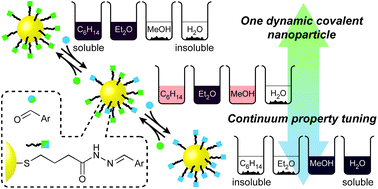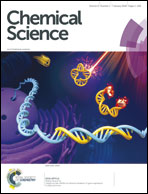Continuum tuning of nanoparticle interfacial properties by dynamic covalent exchange†
Abstract
Surface chemical composition is fundamental to determining properties on the nanoscale, making precise control over surface chemistry critical to being able to optimise nanomaterials for virtually any application. Surface-engineering independent of the preparation of the underlying nanomaterial is particularly attractive for efficient, divergent synthetic strategies, and for the potential to create reactive, responsive and smart nanodevices. For monolayer-stabilised nanoparticles, established methods include ligand exchange to replace the ligand shell in its entirety, encapsulation with amphiphilic (macro)molecules, noncovalent interactions with surface-bound biomolecules, or a relatively limited number of covalent bond forming reactions. Yet, each of these approaches has considerable drawbacks. Here we show that dynamic covalent exchange at the periphery of the nanoparticle-stabilizing monolayer allows surface-bound ligand molecular structure to be substantially modified in mild and reversible processes that are independent of the nanoparticle–molecule interface. Simple stoichiometric variation allows the extent of exchange to be controlled, generating a range of kinetically stable mixed-monolayer compositions across an otherwise identical, self-consistent series of nanoparticles. This approach can be used to modulate nanoparticle properties that are defined by the monolayer composition. We demonstrate switching of nanoparticle solvent compatibility between widely differing solvents – spanning hexane to water – and the ability to tune solubility across the entire continuum between these extremes, all from a single nanoparticle starting point. We also demonstrate that fine control over mixed-monolayer composition influences the assembly of discrete, colloidally stable nanoparticle clusters. By carefully assessing monolayer composition in each state, using both in situ and ex situ methods, we are able to correlate the molecular-level details of the nanoparticle-bound monolayer with system-level properties and behaviour. These empirically determined relationships contribute fundamental insights on nanoscale structure–function relationships, which are currently beyond the capabilities of ab initio prediction.



 Please wait while we load your content...
Please wait while we load your content...